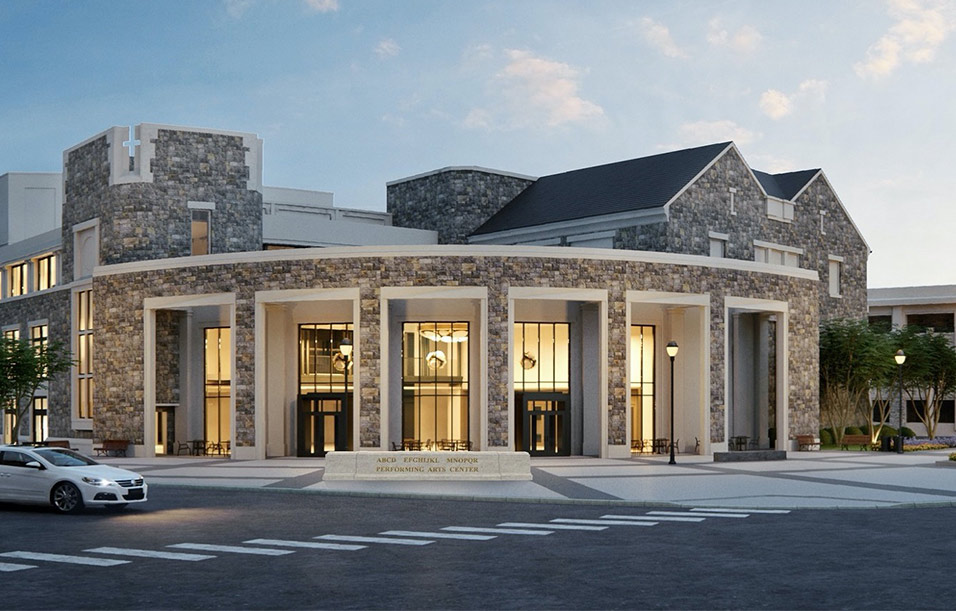Live webinars from the PCI Mid-Atlantic Chapter are an easy way for industry professionals to support their career growth and for students to enhance their academic success in AEC. Presented by seasoned industry experts, these webinars offer deep insights on a variety of topics for continuing education credits. One such industry expert is Anthony (Tony) McConnell, an associate at Robert A.M. Stern Architects (RAMSA), a 265-person firm of architects, interior designers, and supporting staff based in New York City.
Tony is a classically trained architect whose work at the firm has focused on academic and institutional projects, including a presidential library and several buildings for Marist College—most recently a natural science classroom and a new home for the fashion, art, and digital media programs within a renovated industrial building. He also served as project manager for a performing arts center at Villanova University.
In his upcoming webinar on June 17th, Precast Case Studies in Institutional Buildings, Tony will share three case studies that illustrate how architectural precast concrete helped the team at RAMSA achieve client goals in recent institutional projects. In preparation for his webinar, we interviewed Tony to learn more about his academic and professional journey as well as his experience designing and constructing with precast concrete.
Read the interview below to get to know this PCI guest speaker, and register for Tony’s webinar to learn more about building enclosure options, precast solutions, producer working relationships, and more in institutional projects.
 Precast Case Studies in Institutional Buildings – RAMSA
Precast Case Studies in Institutional Buildings – RAMSA
Thursday, June 17th, 2021 at 12:00 p.m. CST
AEC Education & an Early Love for Architecture
PCI-MA: Can you share a little bit about what inspired you to be an architect and how you chose the program at your alma mater, the University of Notre Dame?
McConnell: I always enjoyed solving problems. My dad was a shop teacher and he put simple drafting tools into my hands at a very young age. I also spent countless hours as a child playing the old problem-solving game The Incredible Machine. If you have dreams about bouncing cannon balls off trampolines, you know what I am talking about! As I got older, I found a love for math and geometry and computer aided drafting. Along with the drafting problem-solving and math, I always enjoyed the idea of permanence to buildings; I wanted to design objects that would remain and would help people for a long time after I was gone.
All of those things helped me be very confident that I wanted to be an architect. The big question was where I would get my degree. I did not know a lot about the differences between modernism and traditionalism when I was looking at schools, so that played very little into my decision. Ultimately, I chose the University of Notre Dame because of how it felt to be on campus and how the people there made me feel welcome. It was happy happenstance that it turns out I am a classicist at heart and Notre Dame provided me with the best classical architectural degree available in the United States.
Smart Advice for New Graduates & First-Years
PCI-MA: What advice would you give graduating students in terms of finding employment in the industry, as well as the first few years in the workforce? What are your lessons learned?
McConnell: Spend extra time researching the places you might want to work. Finding an office that is a good fit for what you are passionate about will make you feel happy with the work you do and will make it easier to show your employer that you are good at what you do and that you are excited to do it. A firm that is a good fit benefits both employer and employee. I spent a lot of time researching and interviewing with different firms when I graduated, and it was well worth the extra effort. I have been with RAMSA since I graduated, and I continue to enjoy the work I am doing. I recently had an opportunity to work on a building at Notre Dame and it feels like I am working on a real-life studio project, but I am getting paid to do it!
As for the first-years, be vocal about what you want to work on. Like finding a firm to join, working on the projects that best fit your skills is going to benefit everyone. As a project manager, I don’t just want people who can produce what I need them to. I want people who are excited to do it, people who want to learn more. Those are the employees who I can trust to go the extra mile and who will make our office a better firm in the long run.
The Joy of Institutional Building Architecture
PCI-MA: What’s your favorite part of working on an institutional project like the Villanova Performing Arts Center?
McConnell: I have always been passionate about the idea that architecture should not benefit just the people who occupy the building. I truly believe that buildings should make everyone who interacts with them have a better quality of life. That includes those who work and interact directly with the building as well as those who simply pass by it. Institutional projects give me the opportunity to touch so many different people beyond those who live or work in the building itself.
I also love working with universities like the University of Villanova because it gives me an opportunity to work a very wide range of building types. In the fifteen years I have worked at RAMSA, I’ve worked on everything from business schools to performing arts buildings, and even science buildings that contained state-of-the-art cadaver labs!
Challenges & Advantages of Working with Precast
PCI-MA: You’ve mentioned you’re the go-to expert at RAMSA regarding precast concrete. How did you achieve this informal role at the firm, and what are the advantages and challenges of working with precast?
McConnell: I kind of fell into it. My first precast building wasn’t RAMSA’s first precast building, but it was one of the first to really utilize what we refer to as architectural precast. The project turned out very successfully and I learned a lot from that project. Once the rest of the office saw what we were able to achieve with architectural precast, more and more projects wanted to use it. Since I had the experience, many people came to me for advice on how to achieve similar results. I was also asked to work on more precast projects. Quickly, I had multiple architectural precast projects under my belt, and I have worked with many teams to answer questions and give guidance on projects I wasn’t working with directly.
Some of the advantages of precast are its efficiency in erecting and installation and in its cost. These aren’t new to precast, but what is a newer part of precast envelopes is the ability to create beautiful, architecturally unique facades. Now that architectural precast is becoming more prevalent, more projects are able to take advantage of the speed and price point that precast envelopes have always provided.
I think the biggest challenge is making sure the architectural designs work with the penalization of the panels and that we are able to accommodate the connection points. The penalization can almost always be solved, but it requires creative thinking on both the architects’ and the precasters’ side of the project. I highly recommend that all architectural precast projects utilize some sort of design assist from a precaster to help address these challenges early in the design and incorporate the solutions correctly in the construction documents.
Improving Collaboration Between Producers & Firms
PCI-MA: What advice would you give precast producers to ensure good collaboration and exceptional project outcomes when working with RAMSA and other architecture firms?
McConnell: As I mentioned before, get involved early. The earlier in the design you can be involved, the better the project will turn out. Architects might think we know it all, but I have a secret that you all already know—we don’t. Having a member of the team involved early in the design who knows precast in and out will help us flesh out issues, address those issues, and come up with solutions that everyone is happy with. Solving these issues post-bid, pre-construction is too late to come up with the best solutions.
I also encourage precasters to think outside the box—really be creative with your problem-solving. The people I have worked with are experts in their fields; they are extremely smart when it comes to precast. Even with all the experience I have with architectural precast, I won’t scratch the surface of what our precast partners have seen. Bring that experience to the table and really make yourself an integral part of the design team. If precast producers start to do this more, as far as I am concerned, the sky is the limit for what we can do with precast.
Pushing for Precast Education with Producers’ Help
What can the precast concrete industry do better to help students, professors, owners, and architects to incorporate or learn more about precast in their education programs, as well as in the evaluation process of exterior cladding and building enclosure options?
McConnell: Education is key to architectural precast. Too many people still think of precast as only able to support simple, unarticulated facades. That is simply not true, but if that is the impression owners and students have, they will not bother to consider precast, assuming that it isn’t correct for their project. Sometimes this education may take data and examples. Precast producers should be prepared to help educate and convince owners who are hesitant to consider precast through hard examples and data.
Some of the biggest things I see is owners who want to see examples of architectural precast that has been in place for a certain amount of time. In some cases, that just doesn’t exist, but the producers know what is out there better than any architect. If an example hasn’t been around for fifty years, then show what has been done more recently and provide data that can be understood by a non-precast person to help show them that these systems can, and will, last for many years. This is a place that creativity might come into play—find tests that can be used to show strength and longevity. Again, the architects aren’t the experts, the producers are, and the best information to educate and convince owners and students will come from the precast producers.
About RAMSA
Robert A.M. Stern Architects, LLP (RAMSA), is a 265-person firm of architects, interior designers, and supporting staff. Over its fifty-year history, the firm has established an international reputation as a leading design firm with wide experience in residential, commercial, and institutional work. The firm maintains an attention to detail and commitment to design quality, which have earned international recognition, numerous awards, and citations for design excellence, including National Honor Awards of the American Institute of Architects and a lengthening list of repeat clients.






